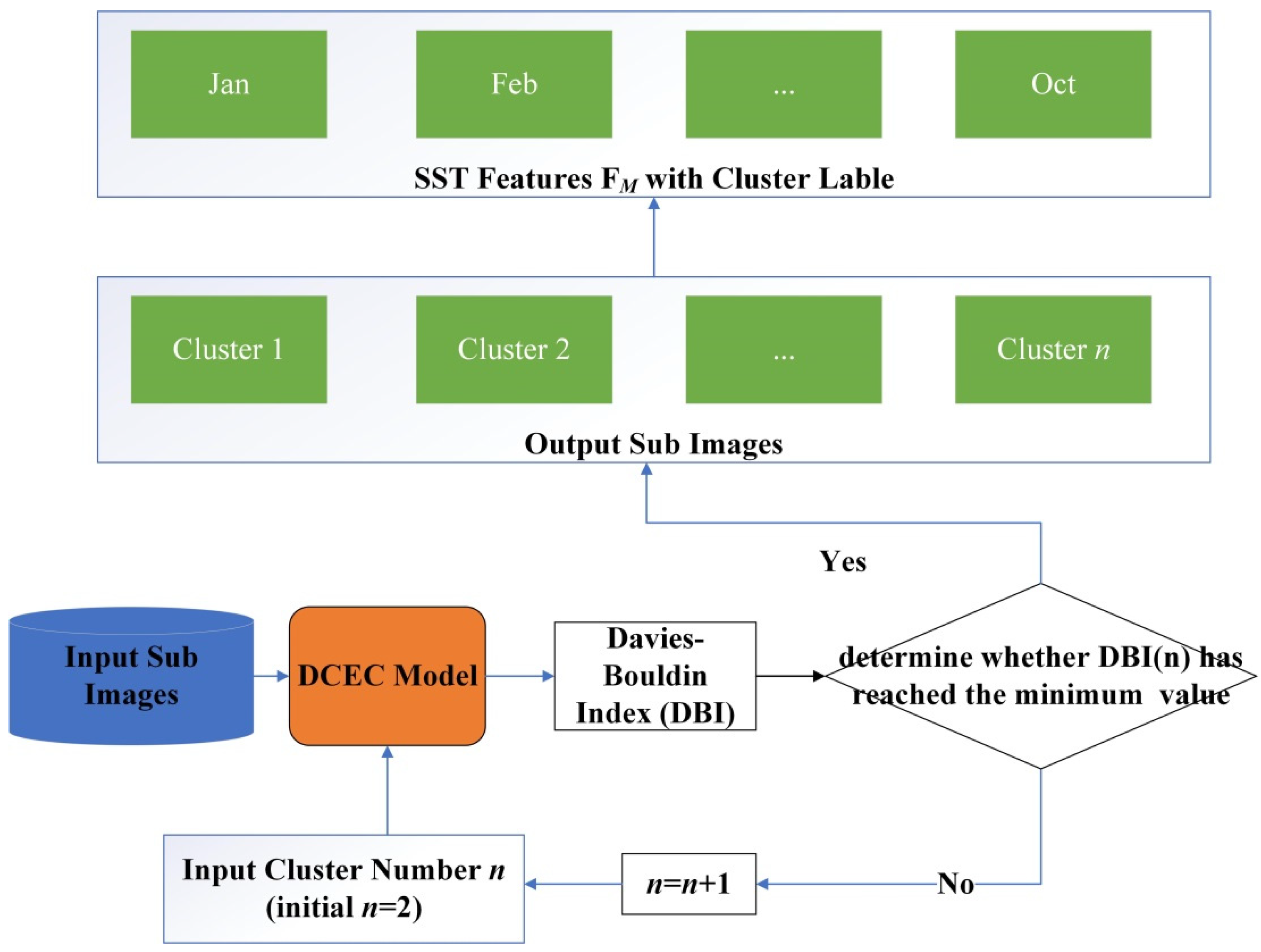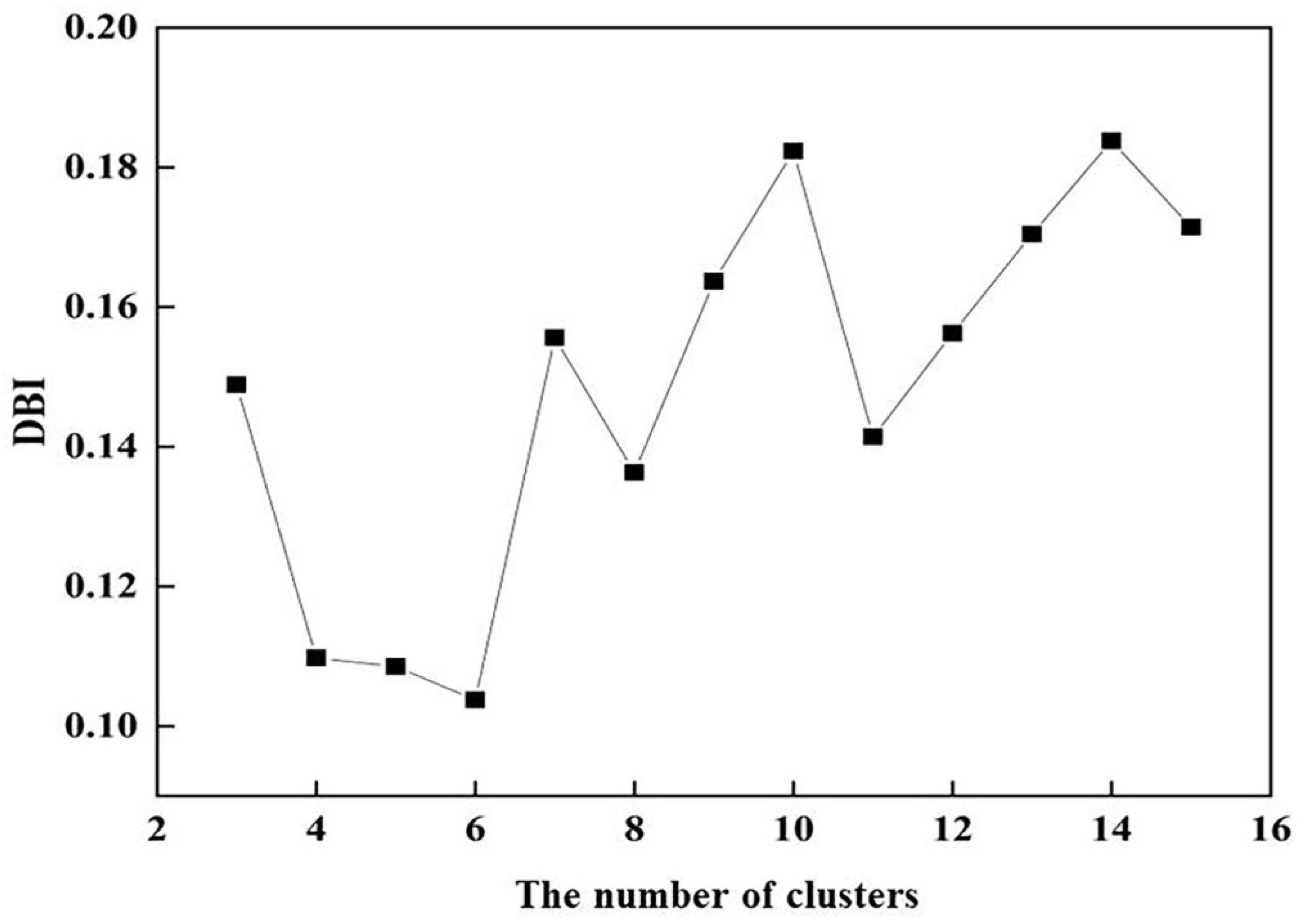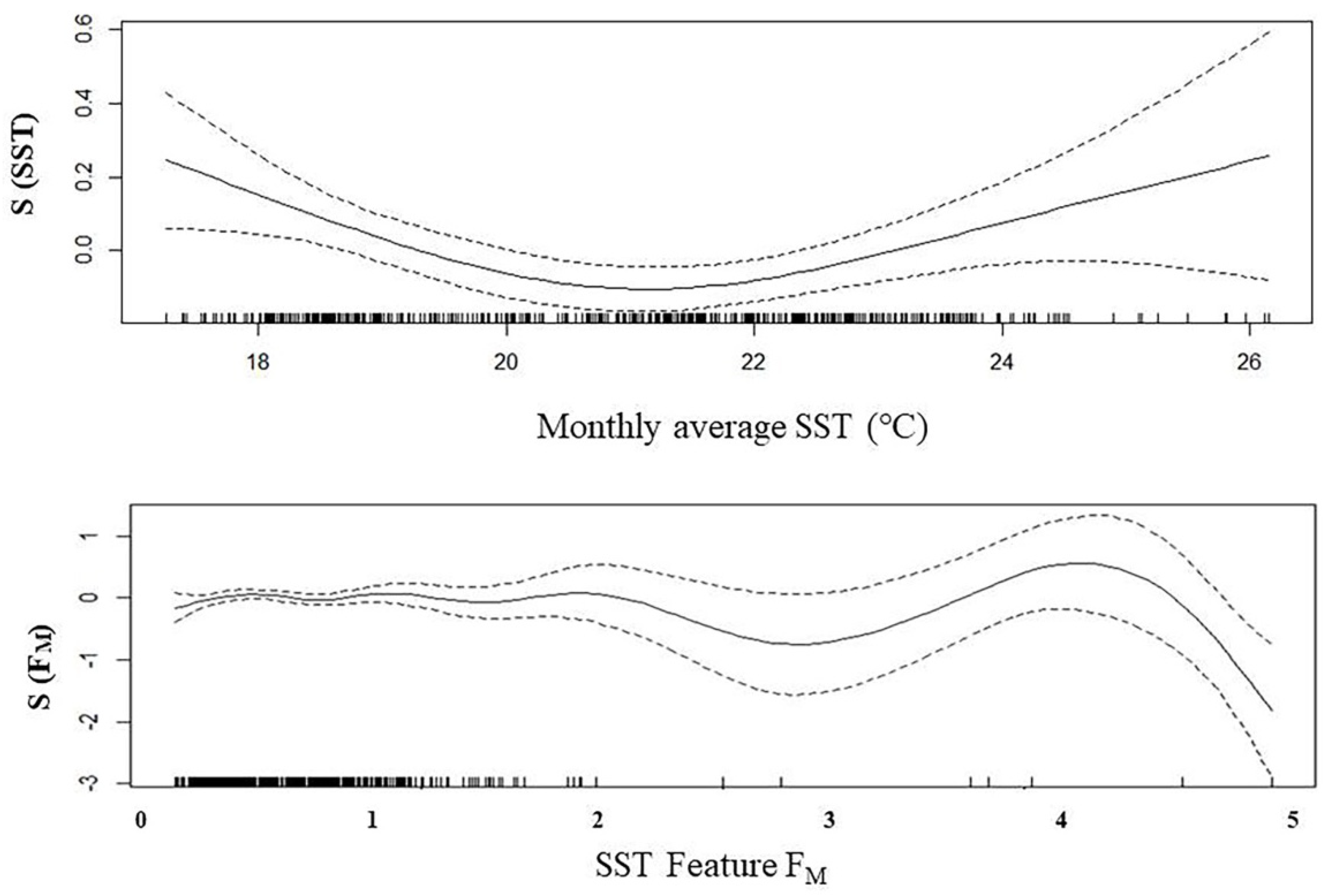Predicting the Fishery Ground of Jumbo Flying Squid (Dosidicus gigas) off Peru by Extracting Features of the Ocean Environment
Abstract
1. Introduction
2. Materials and Methods
2.1. Jumbo Flying Squid Fisheries Data
2.2. Environmental Data
2.3. SST Feature Extraction Based on the DCEC Model
- (1)
- The 46,524 SST sub-images are put into the DCEC model, and the initial cluster number n is set as 2;
- (2)
- The input images pass through the autoencoders, and the clustering layer assigns the images to different clusters;
- (3)
- The Davies–Bouldin index (DBI) is calculated to test the similarity among images within clusters;
- (4)
- The cluster number is set as n + 1, and the above steps (2) and (3) continue until DBI has reached the minimum value, and then the optimal number of clusters is determined.
- (5)
- The output images are assigned the cluster labels based on the optimal clusters and organized into monthly groups.
- (6)
- For each CPUE grid, the SST feature for the Mth month is determined by identifying the assigned cluster labels of the images that appear with the highest frequency within a month. This is expressed as follows:where represents SST feature for the Mth month. The term “Mode” is a statistical term that refers to the value that occurs most frequently among the images in the Mth month; are the labels of images in that specific month. The above feature extraction process is performed based on Python 3.7.
2.4. GAM Construction and Verification
- (1)
- Basic GAM, which uses the traditional monthly average SST value to predict CPUE. To address the issue of underfitting in fishery forecasting models caused by relying solely on a single factor, an additional variable—the monthly average concentration of chlorophyll-a (Chl a)—is included in the model. Chl a has been identified as an important factor influencing squid fishing grounds. We downloaded the monthly average value of Chl a concentration from the NOAA website (https://oceanwatch.pifsc.noaa.gov/ (accessed on 3 September 2023)) from January to December in 2015.The basic GAM was shown in Formula (6):where represents the monthly catch per unit effort; represents the monthly average value of chlorophyll a concentration; represents the monthly average value of sea surface temperature; the s function represents the natural cubic spline smoothing function. The error distribution of the model is assumed to be Gaussian distribution.
- (2)
- Improved GAM, which integrates the extracted SST features along with the average Chl a value. This approach aims to enhance the predictive capability of the model by incorporating more comprehensive and refining representations of the SST monthly feature. The improve GAM model expression is shown in Formula (7):where represents the monthly catch per unit effort; represents the monthly average of the concentration of chlorophyll a; represents the monthly SST extracted feature value; represents the natural cubic spline smoothing function. The error distribution of the model is assumed to be Gaussian distribution.
- (3)
- Full GAM, which includes both the traditional monthly average SST value and the extracted SST features, along with the average Chl a value. We tend to test the improvement of using full variables on the predictive capability of the models. The full GAM model expression is shown in Formula (8):where represents the monthly catch per unit effort; represents the monthly average of the concentration of chlorophyll a; represents the monthly SST extracted feature value; represents the natural cubic spline smoothing function. The error distribution of the model is assumed to be Gaussian distribution.
3. Results
3.1. SST Feature Extraction Results Based on DCEC Model
3.2. Model Evaluation Results
3.3. The Influence of the Explanatory Variables
4. Discussion
4.1. The Effectiveness of the Model in Extracting SST Features
4.2. The Improvement of GAM Based on the Ocean Feature Extraction Approach
4.3. Prospect
5. Conclusions
Author Contributions
Funding
Institutional Review Board Statement
Data Availability Statement
Acknowledgments
Conflicts of Interest
References
- Cao, J.; Chen, X.J.; Chen, Y. Influence of surface oceanographic variability on abundance of the western winter-spring cohort of neon flying squid Ommastrephes bartramii in the NW Pacific Ocean. Mar. Ecol. Prog. Ser. 2009, 381, 119–127. [Google Scholar] [CrossRef]
- Chen, X.J.; Tian, S.Q.; Chen, Y.; Liu, B.L. A modeling approach to identify optimal habitat and suitable fishing grounds for neon flying squid (Ommastrephes bartramii) in the Northwest Pacific Ocean. Fish. Bull. 2010, 108, 1–14. [Google Scholar]
- Chen, X.; Lu, H.; Liu, B.; Chen, Y. Age, growth and population structure of jumbo flying squid, Dosidicus gigas, based on statolith microstructure off the Exclusive Economic Zone of Chilean waters. J. Mar. Biol. Assoc. U. K. 2011, 91, 229–235. [Google Scholar] [CrossRef]
- Waluda, C.M.; Rodhouse, P.G. Remotely sensed mesoscale oceanography of the Central Eastern Pacific and recruitment variability in Dosidicus gigas. Mar. Ecol. Prog. Ser. 2006, 310, 25–32. [Google Scholar] [CrossRef]
- Waluda, C.M.; Yamashiro, C.; Rodhouse, P.G. Influence of the ENSO cycle on the light-fishery for Dosidicus gigas in the Peru Current: An analysis of remotely sensed data. Fish. Res. 2006, 79, 56–63. [Google Scholar] [CrossRef]
- Igarashi, H.; Ichii, T.; Sakai, M.; Ishikawa, Y.; Toyoda, T.; Masuda, S.; Sugiura, N.; Mahapatra, K.; Awaji, T. Possible link between interannual variation of neon flying squid (Ommastrephes bartramii) abundance in the north pacific and the climate phase shift in 1998/1999. Prog. Oceanogr. 2015, 150, 20–34. [Google Scholar] [CrossRef]
- Montecalvo, I.; Le Billon, P.; Arsenault, C.; Schvartzman, M. Ocean predators: Squids, Chinese fleets and the geopolitics of high seas fishing. Mar. Policy 2023, 152, 105584. [Google Scholar] [CrossRef]
- Xu, L.L.; Chen, X.J.; Wang, J.T. Inter-annual variation in abundance index of Dosidicus gigas off Peru during 2003 to 2012. J. Shanghai Ocean. Univ. 2015, 24, 280–286. [Google Scholar]
- Paulino, C.; Segura, M.; Chacón, G. Spatial variability of jumbo flying squid (Dosidicus gigas) fishery related to remotely sensed SST and chlorophyll-a concentration (2004–2012). Fish. Res. 2016, 173, 122–127. [Google Scholar] [CrossRef]
- Hu, G.; Boenish, R.; Gao, C.; Li, B.; Chen, X.; Chen, Y.; Punt, A.E. Spatio-temporal variability in trophic ecology of jumbo squid (Dosidicus gigas) in the southeastern Pacific: Insights from isotopic signatures in beaks. Fish. Res. 2019, 212, 56–62. [Google Scholar] [CrossRef]
- Frawley, T.H.; Briscoe, D.K.; Daniel, P.C.; Britten, G.L.; Crowder, L.B.; Robinson, C.J.; Gilly, W.F. Impacts of a shift to a warm-water regime in the Gulf of California on jumbo squid (Dosidicus gigas). ICES J. Mar. Sci. 2019, 76, 2413–2426. [Google Scholar] [CrossRef]
- Zhang, T.; Song, L.; Yuan, H.; Song, B.; Ngando, N.E. A comparative study on habitat models for adult bigeye tuna in the Indian Ocean based on gridded tuna longline fishery data. Fish. Oceanogr. 2021, 30, 584–607. [Google Scholar] [CrossRef]
- Song, L.; Li, T.; Zhang, T.; Sui, H.; Li, B.; Zhang, M. Comparison of machine learning models within different spatial resolutions for predicting the bigeye tuna fishing grounds in tropical waters of the Atlantic Ocean. Fish. Oceanogr. 2023, 32, 509–526. [Google Scholar] [CrossRef]
- Tian, S.; Chen, X.; Chen, Y.; Xu, L.; Dai, X. Evaluating habitat suitability indices derived from CPUE and fishing effort data for Ommatrephes bratramii in the northwestern Pacific Ocean. Fish. Res. 2009, 95, 181–188. [Google Scholar] [CrossRef]
- Ramos, J.E.; Ramos-Rodríguez, A.; Ferreri, G.B.; Kurczyn, J.A.; Rivas, D.; Salinas-Zavala, C.A. Characterization of the northernmost spawning habitat of Dosidicus gigas with implications for its northwards range extension. Mar. Ecol. Prog. Ser. 2017, 572, 179–192. [Google Scholar] [CrossRef]
- Barth, A.; Alvera-Azcárate, A.; Licer, M.; Beckers, J.M. DINCAE 1.0: A convolutional neural network with error estimates to reconstruct sea surface temperature satellite observations. Geosci. Model Dev. 2020, 13, 1609–1622. [Google Scholar] [CrossRef]
- Medellín-Ortiz, A.; Cadena-Cárdenas, L.; Santana-Morales, O. Environmental effects on the jumbo squid fishery along Baja California’s west coast. Fish. Sci. 2016, 82, 851–861. [Google Scholar] [CrossRef]
- Wang, Y.; Chen, X. The Resource and Biology of Economic Oceanic Squid in the World; Ocean Press: Beijing, China, 2005; pp. 79–295. [Google Scholar]
- Chen, X.; Zhao, X.; Chen, Y. Influence of El Niño/La Niña on the western winter–spring cohort of neon flying squid (Ommastrephes bartramii) in the northwestern Pacific Ocean. ICES J. Mar. Sci. 2007, 64, 1152–1160. [Google Scholar] [CrossRef]
- Guo, X.; Liu, X.; Zhu, E.; Yin, J. Deep clustering with convolutional autoencoders. In Neural Information Processing, Proceedings of the 24th International Conference, ICONIP 2017, Guangzhou, China, 14–18 November 2017; Springer International Publishing: Cham, Switzerland, 2017; pp. 373–382. [Google Scholar] [CrossRef]
- Thomas, J.C.R.; Penas, M.S.; Mora, M. New version of Davies-Bouldin Index for clustering validation based on cylindrical distance. In Proceedings of the 32nd International Conference of the Chilean Computer Science Society (SCCC), Temuco, Chile, 11–15 November 2013; IEEE: Piscataway, NJ, USA, 2013. [Google Scholar] [CrossRef]
- Guisan, A.; Edwards, T.C.; Hastie, T. Generalized linear and generalized additive models in studies of species distributions: Setting the scene. Ecol. Model. 2002, 157, 89–100. [Google Scholar] [CrossRef]
- Himeur, Y.; Rimal, B.; Tiwary, A.; Amira, A. Using artificial intelligence and data fusion for environmental monitoring: A review and future perspectives. Inf. Fusion 2022, 86, 44–75. [Google Scholar] [CrossRef]
- Srivastava, N.; Hinton, G.E.; Krizhevsky, A.; Sutskever, I.; Salakhutdinov, R. Dropout: A simple way to prevent neural networks from overfitting. J. Mach. Learn. Res. 2014, 15, 1929–1958. [Google Scholar]
- Guo, Y.; Liao, J.; Shen, G. A deep learning model with capsules embedded for high-resolution image classification. IEEE J. Sel. Top. Appl. Earth Obs. Remote Sens. 2020, 14, 214–223. [Google Scholar] [CrossRef]
- Duan, Y.; Zheng, X.; Hu, L.; Sun, L. Seismic facies analysis based on deep convolutional embedded clustering. Geophysics 2019, 84, IM87–IM97. [Google Scholar] [CrossRef]
- Castellano, G.; Vessio, G. Deep convolutional embedding for digitized painting clustering. In Proceedings of the 2020 25th International Conference on Pattern Recognition (ICPR), Milan, Italy, 10–15 January 2021; IEEE: Piscataway, NJ, USA, 2021; pp. 2708–2715. [Google Scholar] [CrossRef]
- van Strien, M.J.; Grêt-Regamey, A. Unsupervised deep learning of landscape typologies from remote sensing images and other continuous spatial data. Environ. Model. Softw. 2022, 155, 105462. [Google Scholar] [CrossRef]
- Xiao, J.; Lu, J.; Li, X. Davies Bouldin Index based hierarchical initialization K-means. Intell. Data Anal. 2017, 21, 1327–1338. [Google Scholar] [CrossRef]
- Yu, W.; Chen, X. Ocean warming-induced range-shifting of potential habitat for jumbo flying squid Dosidicus gigas in the Southeast Pacific Ocean off Peru. Fish. Res. 2018, 204, 137–146. [Google Scholar] [CrossRef]
- Alabia, I.D.; Saitoh, S.I.; Mugo, R.; Igarashi, H.; Ishikawa, Y.; Usui, N.; Kamachi, M.; Awaji, T.; Seito, M. Seasonal potential fishing ground prediction of neon flying squid (Ommastrephes bartramii) in the western and central North Pacific. Fish. Oceanogr. 2015, 24, 190–203. [Google Scholar] [CrossRef]
- Taipe, A.; Yamashiro, C.; Mariategui, L.; Rojas, P.; Roque, C. Distribution and concentrations of jumboying squid (Dosidicus gigas) off the peruvian coast between 1991 and 1999. Fish. Res. 2001, 54, 21–32. [Google Scholar] [CrossRef]
- Lamy, F.; Rühlemann, C.; Hebbeln, D.; Wefer, G. High- and low-latitude climate control on the position of the southern Peru-Chile Current during the Holocene. Paleoceanography 2002, 17, 16. [Google Scholar] [CrossRef]
- Penven, P.; Echevin, V.; Pasapera, J.; Colas, F.; Tam, J. Average circulation, seasonal cycle, and mesoscale dynamics of the Peru Current System: A modeling approach. J. Geophys. Res. Ocean. 2005, 110, 10021. [Google Scholar] [CrossRef]
- Ortega, H.; Hidalgo, M. Freshwater fishes and aquatic habitats in Peru: Current knowledge and conservation. Aquat. Ecosyst. Health Manag. 2008, 11, 257–271. [Google Scholar] [CrossRef]
- Argüelles, J.; Csirke, J.; Grados, D.; Tafur, R.; Mendoza, J. Changes in the predominance of phenotypic groups of jumbo flying squid Dosidicus gigas and other indicators of a possible regime change in Peruvian waters. In Proceedings of the 7th Meeting of the Scientific Committee of the SPRFMO, La Havana, Cuba, 5–12 October 2019; pp. 5–12. [Google Scholar]
- Fu, X.; Zhang, C.; Chang, F.; Han, L.; Zhao, X.; Wang, Z.; Ma, Q. Simulation and forecasting of fishery weather based on statistical machine learning. Inf. Process. Agric. 2023; in press. [Google Scholar] [CrossRef]





| Model | AIC | MSE | r |
|---|---|---|---|
| Basic GAM | 905 | 0.045 | 0.21 |
| Improved GAM | 817 | 0.031 | 0.60 |
| Full GAM | 657 | 0.024 | 0.67 |
| Model | Model Factor | p | Interpretation Rate/% |
|---|---|---|---|
| Basic GAM | 0.000 | 7.65 | |
| 0.001 | 11.82 | ||
| 0.004 | 16.18 | ||
| Improved GAM | 0.000 | 6.84 | |
| 0.000 | 15.60 | ||
| 0.002 | 19.76 | ||
| Full GAM | 0.000 | 7.86 | |
| 0.000 | 16.37 | ||
| 0.001 | 13.59 | ||
| + | 0.002 | 34.54 |
Disclaimer/Publisher’s Note: The statements, opinions and data contained in all publications are solely those of the individual author(s) and contributor(s) and not of MDPI and/or the editor(s). MDPI and/or the editor(s) disclaim responsibility for any injury to people or property resulting from any ideas, methods, instructions or products referred to in the content. |
© 2024 by the authors. Licensee MDPI, Basel, Switzerland. This article is an open access article distributed under the terms and conditions of the Creative Commons Attribution (CC BY) license (https://creativecommons.org/licenses/by/4.0/).
Share and Cite
Zhang, T.; Xin, J.; Yu, W.; Yuan, H.; Song, L.; Yang, Z. Predicting the Fishery Ground of Jumbo Flying Squid (Dosidicus gigas) off Peru by Extracting Features of the Ocean Environment. Fishes 2024, 9, 81. https://doi.org/10.3390/fishes9030081
Zhang T, Xin J, Yu W, Yuan H, Song L, Yang Z. Predicting the Fishery Ground of Jumbo Flying Squid (Dosidicus gigas) off Peru by Extracting Features of the Ocean Environment. Fishes. 2024; 9(3):81. https://doi.org/10.3390/fishes9030081
Chicago/Turabian StyleZhang, Tianjiao, Jia Xin, Wei Yu, Hongchun Yuan, Liming Song, and Zhuo Yang. 2024. "Predicting the Fishery Ground of Jumbo Flying Squid (Dosidicus gigas) off Peru by Extracting Features of the Ocean Environment" Fishes 9, no. 3: 81. https://doi.org/10.3390/fishes9030081
APA StyleZhang, T., Xin, J., Yu, W., Yuan, H., Song, L., & Yang, Z. (2024). Predicting the Fishery Ground of Jumbo Flying Squid (Dosidicus gigas) off Peru by Extracting Features of the Ocean Environment. Fishes, 9(3), 81. https://doi.org/10.3390/fishes9030081






